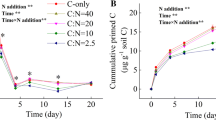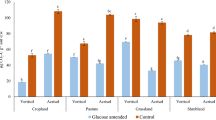Abstract
Background and aims
Atmospheric nitrogen (N) deposition alters the priming effect (PE), which is defined as the change in native soil organic carbon (SOC) decomposition by exogenous C inputs. However, how the priming intensity varies under chemically heterogeneous N deposition, particularly with increasing labile C input, remains unclear.
Methods
We collected soils from a temperate forest in northeastern China that had received simulated organic and/or inorganic N deposition for 6 years. The soils were incubated with or without three levels of 13C-labelled glucose solution for 152 days. CO2 emission and its 13C value were continuously measured to calculate the PE.
Results
Enhanced SOC decomposition (i.e., a positive PE) was observed after glucose addition, regardless of the N deposition form. The PE intensity increased with the increase in the glucose addition level. However, organic N decreased the PE by 12.3-23.2%. The SOC-derived microbial biomass was 16.2-34.3% lower in organic N-treated soil, indicating that preferential utilization of exogenous labile C by microorganisms was responsible for the decrease in PE. The PE inhibition by organic N increased nonlinearly as a function of glucose level. Furthermore, the net annual change in SOC as a balance between the replenishment of added glucose-C and primed C was larger in organic N-treated soil due to a decrease in soil microbial metabolic quotient.
Conclusions
In this study, we found that organic N deposition inhibited the PE, and the inhibition effect was intensified with increasing C inputs, favouring SOC sequestration.







Similar content being viewed by others
References
Aye NS, Butterly CR, Sale PWG, Tang CX (2018) Interactive effects of initial pH and nitrogen status on soil organic carbon priming by glucose and lignocellulose. Soil Biol Biochem 123:33–44. https://doi.org/10.1016/j.soilbio.2018.04.027
Blagodatskaya E, Kuzyakov Y (2008) Mechanisms of real and apparent priming effects and their dependence on soil microbial biomass and community structure: critical review. Biol Fertil soils 45:115–131. https://doi.org/10.1007/s00374-008-0334-y
Blagodatskaya E, Blagodatsky S, Anderson T, Kuzyakov Y (2007) Priming effects in Chernozem induced by glucose and N in relation to microbial growth strategies. Appl Soil Ecol 37:95–105. https://doi.org/10.1016/j.apsoil.2007.05.002
Blair GJ, Lefroy RDB, Lisle L (1995) Soil carbon fractions based on their degree of oxidation, and the development of a carbon management index for agricultural systems. Aust J Agric Res 46:1459–1466. https://doi.org/10.1071/AR9951459
Chang RY, Li N, Sun XY et al (2018) Nitrogen addition reduces dissolved organic carbon leaching in a montane forest. Soil biol Biochem 127:31–38. https://doi.org/10.1016/j.soilbio.2018.09.006
Chen J, Luo YQ, Li JW et al (2017) Costimulation of soil glycosidase activity and soil respiration by nitrogen addition. Glob Chang biol 23:1328–1337. https://doi.org/10.1111/gcb.13402
Chen RR, Senbayram M, Blagodatsky S et al (2014) Soil C and N availability determine the priming effect: microbial N mining and stoichiometric decomposition theories. Glob Chang biol 20:2356–2367. https://doi.org/10.1111/gcb.12475
Chen ZM, Xu YH, He YJ et al (2018) Nitrogen fertilization stimulated soil heterotrophic but not autotrophic respiration in cropland soils: a greater role of organic over inorganic fertilizer. Soil biol Biochem 116:253–264. https://doi.org/10.1016/j.soilbio.2017.10.029
Cornell SE (2011) Atmospheric nitrogen deposition: revisiting the question of the importance of the organic component. Environ Pollut 159:2214–2222. https://doi.org/10.1016/j.proenv.2011.05.010
Cusack DF, Lee JK, Mccleery TL, Lecroy CS (2015) Exotic grasses and nitrate enrichment alter soil carbon cycling along an urban-rural tropical forest gradient. Glob Chang Biol 21:4481–4496. https://doi.org/10.1111/gcb.13066
De Graaff MA, Jastrow JD, Gillette S, Johns A, Wullschleger SD (2014) Differential priming of soil carbon driven by soil depth and root impacts on carbon availability. Soil Biol Biochem 69:147–156. https://doi.org/10.1016/j.soilbio.2013.10.047
Di Lonardo DP, De Boer W, Klein Gunnewiek PJA et al (2017) Priming of soil organic matter: chemical structure of added compounds is more important than the energy content. Soil Biol Biochem 108:41–54. https://doi.org/10.1016/j.soilbio.2017.01.017
Dijkstra FA, Carrillo Y, Pendall E, Morgan JA (2013) Rhizosphere priming: a nutrient perspective. Front Microbiol 4: 216. https://doi.org/10.3389/fmicb.2013.00216
Drake JE, Ba D, M-a G et al (2013) Stoichiometry constrains microbial response to root exudation- insights from a model and a field experiment in a temperate forest. Biogeosciences 10:821–838. https://doi.org/10.5194/bg-10-821-2013
Du YH, Guo P, Liu J.Q et al (2014) Different types of nitrogen deposition show variable effects on the soil carbon cycle process of temperate forests. Glob Chang Biol 20:3222–3228. doi: https://doi.org/10.1111/gcb.12555
Fang YY, Nazaries L, Singh BK, Singh BP (2018) Microbial mechanisms of carbon priming effects revealed during the interaction of crop residue and nutrient inputs in contrasting soils. Glob Chang biol 24:2775–2790. https://doi.org/10.1016/j.soilbio.2018.09.003
Fontaine S, Henault C, Aamor A et al (2011) Fungi mediate long term sequestration of carbon and nitrogen in soil through their priming effect. Soil Biol Biochem 43:86–96. https://doi.org/10.1016/j.soilbio.2010.09.017
Gallo ME, Lauber CL, Cabaniss SE et al (2005) Soil organic matter and litter chemistry response to experimental N deposition in northern temperate deciduous forest ecosystems. Glob Chang biol 11:1514–1521. https://doi.org/10.1111/j.1365-2486.2005.001001.x
Galloway JN, Townsend AR, Erisman JW et al (2008) Transformation of the nitrogen cycle: recent trends, questions, and potential solutions. Sci Total Environ 320:889–892. https://doi.org/10.1126/science.1136674
Garcia-Palacios P, Vandegehuchte ML, Shaw EA et al (2015) Are there links between responses of soil microbes and ecosystem functioning to elevated CO2, N deposition and warming? A global perspective. Glob Chang Biol 21:1590–1600. https://doi.org/10.1111/gcb.12788
Ghani A, Dexter M, Perrott KW (2003) Hot-water extractable carbon in soils: a sensitive measurement for determining impacts of fertilization, grazing and cultivation. Soil Biol Biochem 35:1231–1243. https://doi.org/10.1016/S0038-0717(03)00186-X
Gong ZT, Chen ZC, Luo GB, Zhang GL, Zhao WJ (1999) Soil reference with Chinese soil taxonomy. Soils 31:57–63
Guenet B, Juarez S, Bardoux G, Abbadie L, Chenu C (2012) Evidence that stable C is as vulnerable to priming effect as is more labile C in soil. Soil Biol Biochem 52:43–48. https://doi.org/10.1016/j.soilbio.2012.04.001
Heuck C, Weig A, Spohn M (2015) Soil microbial biomass C: N:P stoichiometry and microbial use of organic phosphorus. Soil Biol Biochem 85:119–129. https://doi.org/10.1016/j.soilbio.2015.02.029
IPCC (2013) Climate change 2013: the physical scientific basis. Contribution of working group to the fifth assessment report of the intergovernmental. Cambridge University Press, Cambridge and New York
Janssens IA, Dieleman W, Luyssaert S et al (2010) Reduction of forest soil respiration in response to nitrogen deposition. Nat Geosci 3:315. doi: 10.1038 /ngeo844
Kumar A, Kuzyakov Y, Pausch J (2016) Maize rhizosphere priming: field estimates using 13C natural abundance. Plant soil 409:87–97. https://doi.org/10.1007/s11104-016-2958-2
Kuzyakov Y, Friedel JK, Stahr K (2000) Review of mechanisms and quantification of priming effects. Soil biol Biochem 32:1485–1498. https://doi.org/10.1016/S0038-0717(00)00084-5
Li SS, Du YH, Guo P et al (2014) Effects of different types of N deposition on the fungal decomposition activities of temperate forest soils. Sci Total Environ 497:91–96. https://doi.org/10.1016/j.scitotenv.2014.07.098
Liang JY, Zhou ZH, Huo CF et al (2018) More replenishment than priming loss of soil organic carbon with additional carbon input. Nat Commun 9:3175. https://doi.org/10.1038/s41467-018-05667-7
Liu XJA, Sun JR, Mau RL et al (2017) Labile carbon input determines the direction and magnitude of the priming effect. Appl Soil Ecol 109:7–13. https://doi.org/10.1016/j.apsoil.2016.10.002
Lu RK (2000) Soil and agro-chemistry analytical methods. China Agriculture Science and Technology Press, Beijing
Maestrini B, Abiven S, Singh N et al (2014) Carbon losses from pyrolysed and original wood in a forest soil under natural and increased N deposition. Biogeosciences 11:5199–5213. https://doi.org/10.5194/bg-11-5199-2014
Murphy CJ, Baggs EM, Morley N, Wall DP, Paterson E (2017) Nitrogen availability alters rhizosphere processes mediating soil organic matter mineralisation. Plant Soil 417:499–510. https://doi.org/10.1007/s11104-017-3275-0
Nottingham AT, Turner BL, Chamberlain PM, Stott AW, Tanner EVJ (2012) Priming and microbial nutrient limitation in lowland tropical forest soils of contrasting fertility. Biogeochemistry 111:219–237. https://doi.org/10.1007/s10533-011-9637-4
Paterson E, Sim A (2013) Soil-specific response functions of organic matter mineralization to the availability of labile carbon. Glob Chang Biol 19:1562–1571. https://doi.org/10.1111/gcb.12140
Qiao N, Schaefer D, Blagodatskaya E et al (2013) Labile carbon retention compensates for CO2 released by priming in forest soils. Glob Chang Biol 20:1943–1954. https://doi.org/10.1111/gcb.12458
Qiu QY, Wu LF, Ouyang Z, Li BB, Xu YY (2016) Different effects of plant-derived dissolved organic matter (DOM) and urea on the priming of soil organic carbon. Environ Sci-proc imp 18:330–341. https://doi.org/10.1039/c5em00446b
Sinsabaugh RL (2010) Phenol oxidase, peroxidase and organic matter dynamics of soil. Soil Biol Biochem 42:391–404. https://doi.org/10.1016/j.soilbio.2009.10.014
Sun T, Dong L, Wang ZW, Lü XT, Mao ZJ (2016) Effects of long-term nitrogen deposition on fine root decomposition and its extracellular enzyme activities in temperate forests. Soil Biol Biochem 93:50–59. https://doi.org/10.1016/j.soilbio.2015.10.023
Thomas RQ, Canham CD, Weathers KC, Goodale CL (2010) Increased tree carbon storage in response to nitrogen deposition in the US. Nat Geosci 3:13. https://doi.org/10.1038/ngeo721
Tian J, Pausch J, Yu GR et al (2015) Aggregate size and their disruption affect 14C-labeled glucose mineralization and priming effect. Appl Soil Ecol 90:1–10. https://doi.org/10.1016/j.apsoil.2015.01.014
Tian P, Zhang JB, Cai ZC, Jin GZ (2018) Different response of CO2 and N2O fluxes to N deposition with seasons in a temperate forest in northeastern China. J Soils Sediments 18:1821–1831. https://doi.org/10.1007/s11368-018-1919-1
Tian P, Mason-Jones K, Liu SE et al (2019) Form of nitrogen deposition affects soil organic matter priming by glucose and cellulose. Biol Fertil Soils 55:383–391. https://doi.org/10.1007/s00374-019-01357-8
Vance ED, Brookes PC, Jenkinson DS (1987) An extraction method for measuring soil microbial biomass C. soil biol Biochem 19: 703–707. 10.1016 /0038-0717(87)90052-6
Wang H, Xu W, Hu G et al (2015) The priming effect of soluble carbon inputs in organic and mineral soils from a temperate forest. Oecologia 178:1239–1250. https://doi.org/10.1007/s00442-015-3290-x
Wang QK, Liu SP, Wang SL (2013) Debris manipulation alters soil CO2 efflux in a subtropical plantation forest. Geoderma 192:316–322. https://doi.org/10.1016/j.geoderma.2012.06.027
Wang QK, Wang SL, He TX, Liu L, Wu JB (2014) Response of organic carbon mineralization and microbial community to leaf litter and nutrient additions in subtropical forest soils. Soil biol Biochem 71:13–20. https://doi.org/10.1016/j.soilbio.2014.01.004
Wang XJ, Tang CX, Severi J, Butterly CR, Baldock JA (2016) Rhizosphere priming effect on soil organic carbon decomposition under plant species differing in soil acidification and root exudation. New Phytol 211:864–873. https://doi.org/10.1111/nph.13966
Wild B, Wanek W, Postl W, Richter A (2010) Contribution of carbon fixed by Rubisco and PEPC to phloem export in the Crassulacean acid metabolism plant Kalanchoë daigremontiana. J Exp Bot 61:1375–1383. https://doi.org/10.1093/jxb/erq006
Xu Q, Wang X, Tang C (2018) The effects of elevated CO2 and nitrogen availability on rhizosphere priming of soil organic matter under wheat and white lupin. Plant Soil 425:375–387. https://doi.org/10.1007/s11104-018-3601-1
Zang HD, Blagodatskaya E, Wang JY, Xu XL, Kuzyakov Y (2017) Nitrogen fertilization increases rhizodeposit incorporation into microbial biomass and reduces soil organic matter losses. Biol Fertil Soils 53:419–429. https://doi.org/10.1007/s00374-017-1194-0
Zhao ZW, Ge TD, Gunina A et al (2018) Carbon and nitrogen availability in paddy soil affects rice photosynthate allocation, microbial community composition, and priming: combining continuous 13C labeling with PLFA analysis. Plant Soil. https://doi.org/10.1007/s11104-018-3873-5
Zhu ZK, Ge TD, Liu SL et al (2018) Rice rhizodeposits affect organic matter priming in paddy soil: the role of N fertilization and plant growth for enzyme activities, CO2 and CH4 emissions. Soil Biol Biochem 116:369–377. https://doi.org/10.1016/j.soilbio.2017.11.001
Acknowledgements
We would like to thank Dr. Bahar S. Razavi for her help with the paper improvement. We also thank the editor and three anonymous reviewers for their constructive comments and suggestions to improve this manuscript. This research was supported by the National Key Research and Development Program of China (grant No. 2016YFA0600801) and the National Natural Science Foundation of China (grant No. 31830015 and 31570466). The publication was financially supported by the “RUDN University Program 5-100”.
Author information
Authors and Affiliations
Corresponding author
Ethics declarations
Competing interests
The authors declare no competing financial interests.
Additional information
Responsible Editor: Feike A. Dijkstra.
Publisher’s note
Springer Nature remains neutral with regard to jurisdictional claims in published maps and institutional affiliations.
Electronic supplementary material
ESM 1
(DOC 58 kb)
Rights and permissions
About this article
Cite this article
Tian, P., Liu, S., Wang, Q. et al. Organic N deposition favours soil C sequestration by decreasing priming effect. Plant Soil 445, 439–451 (2019). https://doi.org/10.1007/s11104-019-04331-3
Received:
Accepted:
Published:
Issue Date:
DOI: https://doi.org/10.1007/s11104-019-04331-3




